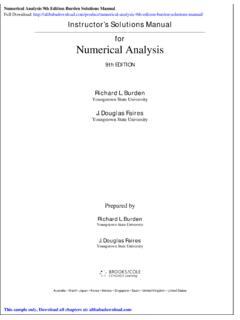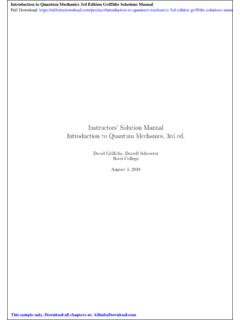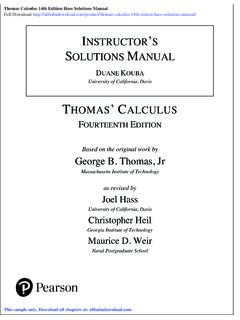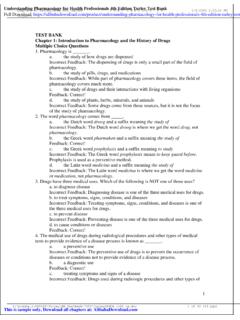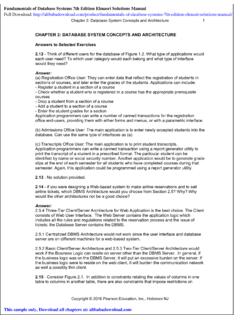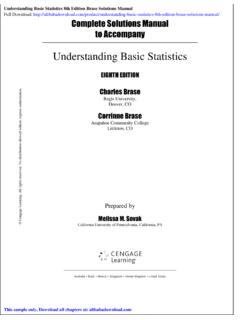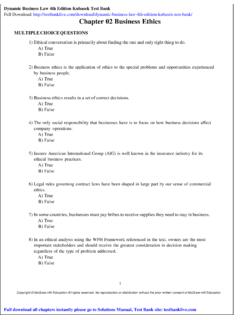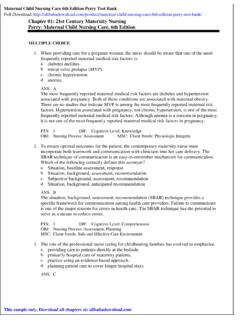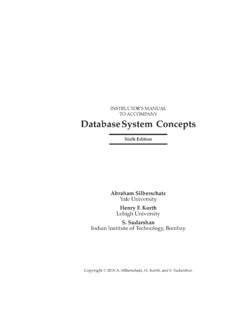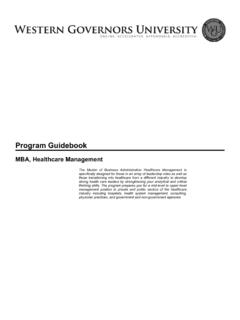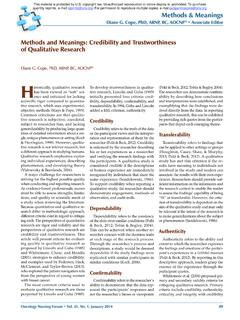Transcription of Fundamentals of Corporate Finance 12th Edition Ross ...
1 Solutions Manual Fundamentals of Corporate Finance 12th Edition Ross, Westerfield, and Jordan 06-15-2018 Prepared by Brad Jordan University of Kentucky Joe Smolira Belmont University Fundamentals of Corporate Finance 12th Edition Ross Solutions ManualFull Download: sample only, Download all chapters at: CHAPTER 1 INTRODUCTION TO Corporate Finance Answers to Concepts review and critical thinking Questions 1. Capital budgeting (deciding whether to expand a manufacturing plant), capital structure (deciding whether to issue new equity and use the proceeds to retire outstanding debt), and working capital management (modifying the firm s credit collection policy with its customers). 2. Disadvantages: unlimited liability, limited life, difficulty in transferring ownership, difficulty in raising capital funds.
2 Some advantages: simpler, less regulation, the owners are also the managers, sometimes personal tax rates are better than Corporate tax rates. 3. The primary disadvantage of the Corporate form is the double taxation to shareholders of distributed earnings and dividends. Some advantages include: limited liability, ease of transferability, ability to raise capital, and unlimited life. 4. In response to Sarbanes-Oxley, small firms have elected to go dark because of the costs of compliance. The costs to comply with Sarbox can be several million dollars, which can be a large percentage of a small firm s profits. A major cost of going dark is less access to capital. Since the firm is no longer publicly traded, it can no longer raise money in the public market. Although the company will still have access to bank loans and the private equity market, the costs associated with raising funds in these markets are usually higher than the costs of raising funds in the public market.
3 5. The treasurer s office and the controller s office are the two primary organizational groups that report directly to the chief financial officer. The controller s office handles cost and financial accounting, tax management, and management information systems, while the treasurer s office is responsible for cash and credit management, capital budgeting, and financial planning. Therefore, the study of Corporate Finance is concentrated within the treasury group s functions. 6. To maximize the current market value (share price) of the equity of the firm (whether it s publicly traded or not). 7. In the Corporate form of ownership, the shareholders are the owners of the firm. The shareholders elect the directors of the corporation, who in turn appoint the firm s management. This separation of ownership from control in the Corporate form of organization is what causes agency problems to exist.
4 Management may act in its own or someone else s best interests, rather than those of the shareholders. If such events occur, they may contradict the goal of maximizing the share price of the equity of the firm. 8. A primary market transaction. 2 SOLUTIONS MANUAL 9. In auction markets like the NYSE, brokers and agents meet at a physical location (the exchange) to match buyers and sellers of assets. Dealer markets like NASDAQ consist of dealers operating at dispersed locales who buy and sell assets themselves, communicating with other dealers either electronically or literally over-the-counter. 10. Such organizations frequently pursue social or political missions, so many different goals are conceivable. One goal that is often cited is revenue minimization; that is, provide whatever goods and services are offered at the lowest possible cost to society.
5 A better approach might be to observe that even a not-for-profit business has equity. Thus, one answer is that the appropriate goal is to maximize the value of the equity. 11. Presumably, the current stock value reflects the risk, timing, and magnitude of all future cash flows, both short-term and long-term. If this is correct, then the statement is false. 12. An argument can be made either way. At the one extreme, we could argue that in a market economy, all of these things are priced. There is thus an optimal level of, for example, ethical and/or illegal behavior, and the framework of stock valuation explicitly includes these. At the other extreme, we could argue that these are noneconomic phenomena and are best handled through the political process. A classic (and highly relevant) thought question that illustrates this debate goes something like this: A firm has estimated that the cost of improving the safety of one of its products is $30 million.
6 However, the firm believes that improving the safety of the product will only save $20 million in product liability claims. What should the firm do? 13. The goal will be the same, but the best course of action toward that goal may be different because of differing social, political, and economic institutions. 14. The goal of management should be to maximize the share price for the current shareholders. If management believes that it can improve the profitability of the firm so that the share price will exceed $35, then they should fight the offer from the outside company. If management believes that this bidder or other unidentified bidders will actually pay more than $35 per share to acquire the company, then they should still fight the offer. However, if the current management cannot increase the value of the firm beyond the bid price, and no other higher bids come in, then management is not acting in the interests of the shareholders by fighting the offer.
7 Since current managers often lose their jobs when the corporation is acquired, poorly monitored managers have an incentive to fight Corporate takeovers in situations such as this. 15. We would expect agency problems to be less severe in countries with a relatively small percentage of individual ownership. Fewer individual owners should reduce the number of diverse opinions concerning Corporate goals. The high percentage of institutional ownership might lead to a higher degree of agreement between owners and managers on decisions concerning risky projects. In addition, institutions may be better able to implement effective monitoring mechanisms on managers than can individual owners, based on the institutions deeper resources and experiences with their own management. The increase in institutional ownership of stock in the United States and the growing activism of these large shareholder groups may lead to a reduction in agency problems for corporations and a more efficient market for Corporate control.
8 CHAPTER 1 - 3 16. How much is too much? Who is worth more, Mark Parker or LeBron James? The simplest answer is that there is a market for executives just as there is for all types of labor. Executive compensation is the price that clears the market. The same is true for athletes and performers. Having said that, one aspect of executive compensation deserves comment. A primary reason executive compensation has grown so dramatically is that companies have increasingly moved to stock-based compensation. Such movement is obviously consistent with the attempt to better align stockholder and management interests. In recent years, stock prices have soared, so management has cleaned up. It is sometimes argued that much of this reward is due to rising stock prices in general, not managerial performance. Perhaps in the future, executive compensation will be designed to reward only differential performance, that is, stock price increases in excess of general market increases.
9 CHAPTER 2 FINANCIAL STATEMENTS, TAXES, AND CASH FLOW Answers to Concepts review and critical thinking Questions 1. Liquidity measures how quickly and easily an asset can be converted to cash without significant loss in value. It s desirable for firms to have high liquidity so that they have a large factor of safety in meeting short-term creditor demands. However, since liquidity also has an opportunity cost associated with it namely that higher returns can generally be found by investing the cash into productive assets low liquidity levels are also desirable to the firm. It s up to the firm s financial management staff to find a reasonable compromise between these opposing needs. 2. The recognition and matching principles in financial accounting call for revenues, and the costs associated with producing those revenues, to be booked when the revenue process is essentially complete, not necessarily when the cash is collected or bills are paid.
10 Note that this way is not necessarily correct; it s the way accountants have chosen to do it. 3. Historical costs can be objectively and precisely measured whereas market values can be difficult to estimate, and different analysts would come up with different numbers. Thus, there is a trade-off between relevance (market values) and objectivity (book values). 4. Depreciation is a noncash deduction that reflects adjustments made in asset book values in accordance with the matching principle in financial accounting. Interest expense is a cash outlay, but it s a financing cost, not an operating cost. 5. Market values can never be negative. Imagine a share of stock selling for $20. This would mean that if you placed an order for 100 shares, you would get the stock along with a check for $2,000. How many shares do you want to buy?
